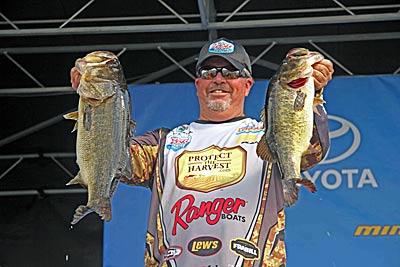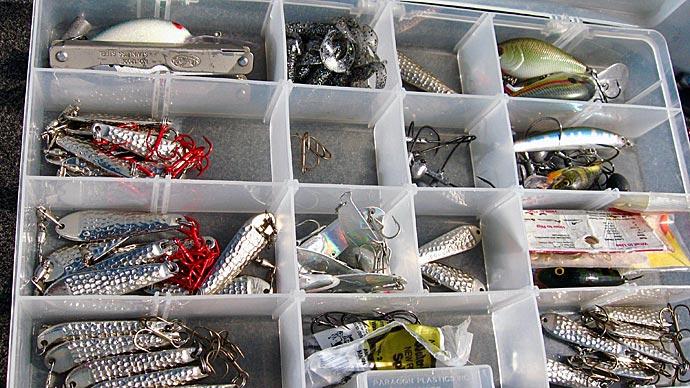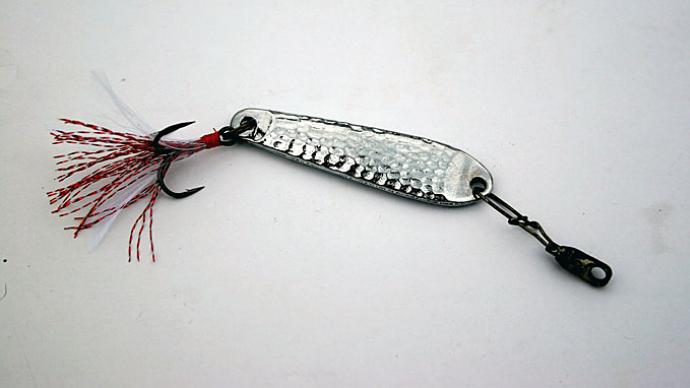
You don’t see many people spooning for bass in the summer, but John Murray uses them a lot, especially as the weather gets hotter and the fish go deeper and quit chasing reaction baits – he says that’s usually around mid-July or so. The beauty of spoons, says Murray, is that they’ll catch everything in the lake, and you can fish them in so many ways and on almost any structure. They work as well in summer as in winter – maybe even better. Whether fishing MLF, FLW, or guiding on his home lake, John always keeps a spoon on deck this time of year.
Gear
You need to match your tackle to your spoon, John says. The smallest spoon he starts with weighs one ounce, so he favors a 7-1/2 foot Sixgill rod with a strong backbone but a little tip for casting – about a medium-heavy action. The length helps with hooksets, and so does a high-speed reel -- Murray uses a 7:1 Sixgill reel. He will use this setup with almost every spoon in his box unless he moves up to a 12-inch flutter spoon, and then he’ll beef it up even more. He spools up with Gamma 16- or even 20-pound-test fluorocarbon line.
For the spoons themselves, he prefers white over any other color. He says white is even more visible than silver, and he generally only uses silver in very clear water – like Lake Mead clear. He also replaces the hooks with a wide gap Gamakatsu or Owner treble hook, and he prefers to have feathers tied to the trebles, so the fish are attracted to them. A buddy of his ties up his feathered trebles, but you can learn to do that yourself or even buy trebles already feathered. If the spoon doesn’t come with a swivel, he always adds one, but he doesn’t use shiny swivels because he doesn’t want the fish to hit those.
The type of spoon he chooses depends on how he will fish it. For casting up on flats and such, he’ll pick up a flutter spoon such as a Lake Fork Flutter Spoon – the kind that looks like the cupped bowl of a spoon. If he’s going to be jigging, he uses something like a Hopkins or a Crippled Herring. On lakes with gizzard shad, he’ll use giant spoons, matching the hatch, and on lakes where shad are the primary baitfish, he chooses smaller spoons, but he still prefers white. The exceptions are chartreuse for smallmouth and gold if the primary baitfish are golden shiners.
Where To Fish A Spoon

Murray has always been excellent at reading and using electronics. I remember back in the day when he was the first fisherman I knew who had a paper graph. With his graph, his fishing always starts before he even gets out of the no-wake area by the ramp. These days he runs Garmin graphs with maps – “These graphs now tell us so much more than they used to,” he says, “and these Garmins are perfect for what I do.” He finds fish, and to do that, he first looks for the thermocline. “I’m looking for the level of activity,” he says, “and on my graph, I can see a layer of baitfish and activity that is very obvious, especially on the western lakes.” The depth of that layer is his starting point – the bass will be within five feet of that, he says.
Once Murray knows the depth the baitfish are at, he uses the mapping features on the Garmin to show him areas where that depth intersects with structure – points, drop-offs, rock piles, etc. You don’t have to stay in an area for long because they will react and hit it quickly with a spoon. You can go from one area to the next and keep hitting the zones you find on the map.
Some of his favorite spooning areas are standing timber, drop-off, channels, and any place where the channel takes a bend. He says some small channels that go up the coves are excellent big-fish spots. He also loves to spoon rock piles for smallmouth, and they particularly like chartreuse spoons. He casts a spoon to boils, skipping it back and then letting it sink to the action while watching the line.

Murray says a spoon is as good a structure bait as a worm or a jig, and when the fish slow down in the dog days of summer, and you can’t seem to get them to bite a worm or a jig, a spoon will often do the trick.
Techniques
In the summer, casting a big flutter spoon and ripping it back to the boat is one of Murray’s go-to techniques. This will work, he says, even when the fish won’t take a worm. He’ll cast up on a shallow ledge (five to twenty feet deep) and rip it back to the boat. These hot-weather fish don’t eat the bait – they get agitated and swipe at it, so you’ll get a lot of fish that are not hooked very well. This is where the fast reel shines – you need to jerk it up and take up line quickly so you can set the hook.
Ninety percent of the bites on a spoon will come as it falls after you rip it or lift it, Murray says, and often the big fish bite the softest. Because the line is slack at this time, you likely won’t feel anything: the spoon doesn’t fall as far as it should. Watching the line is the key to success – if it suddenly bows when you know it isn’t hitting bottom, take up the slack and hit it quick. If the fish are nipping at it and you cannot get one on, change the color or lighten up the bait a bit, he says.
When he’s casting and ripping a spoon back, he casts out, lets it sink a bit, then swims and jerks it back to the boat, letting it get to within a foot or two off the bottom before ripping it back up. Let it fall, lift the rod, drop it, reel in the slack, and repeat back to the boat. You want it to fall on the slack line to get the proper fluttering action. Other times he’ll bring it back with little twitches, keeping it at the depth where he can see suspended fish. He says that fish within two or three feet of the bottom are prime targets for a spoon.
On deep reservoirs, he’ll often fish spoons close to the dam or other steep structure, dropping it down to baitfish level, then working it up and down to the fish, then ripping it up before “killing” it allowing it to flutter back down. The bigger the spoon, the higher he rips it. He splits the screen and zooms in to see the fish and the spoon. Murray says that you can sometimes catch ten or fifteen fish off a spot no bigger than your living room.
When fishing boat docks and trees, Murray sometimes puts a spoon inside a white tube bait to slow it down and give the spoon a better profile. He says you can also put scent inside the tube, which is particularly good for fishing things like boat docks and trees. He tightens up on the line and then lets it slack when he gets snagged, and the spoon will often fall right off the snag.
Murray once told me he’d won more money on spoons in winter than any other bait, but they are also one of his favorite summer baits. Keep one on deck this summer and give it a try when the fish are being fussy. You could be in for a big surprise.
BassResource may receive a portion of revenues if you make a purchase using a link above.




